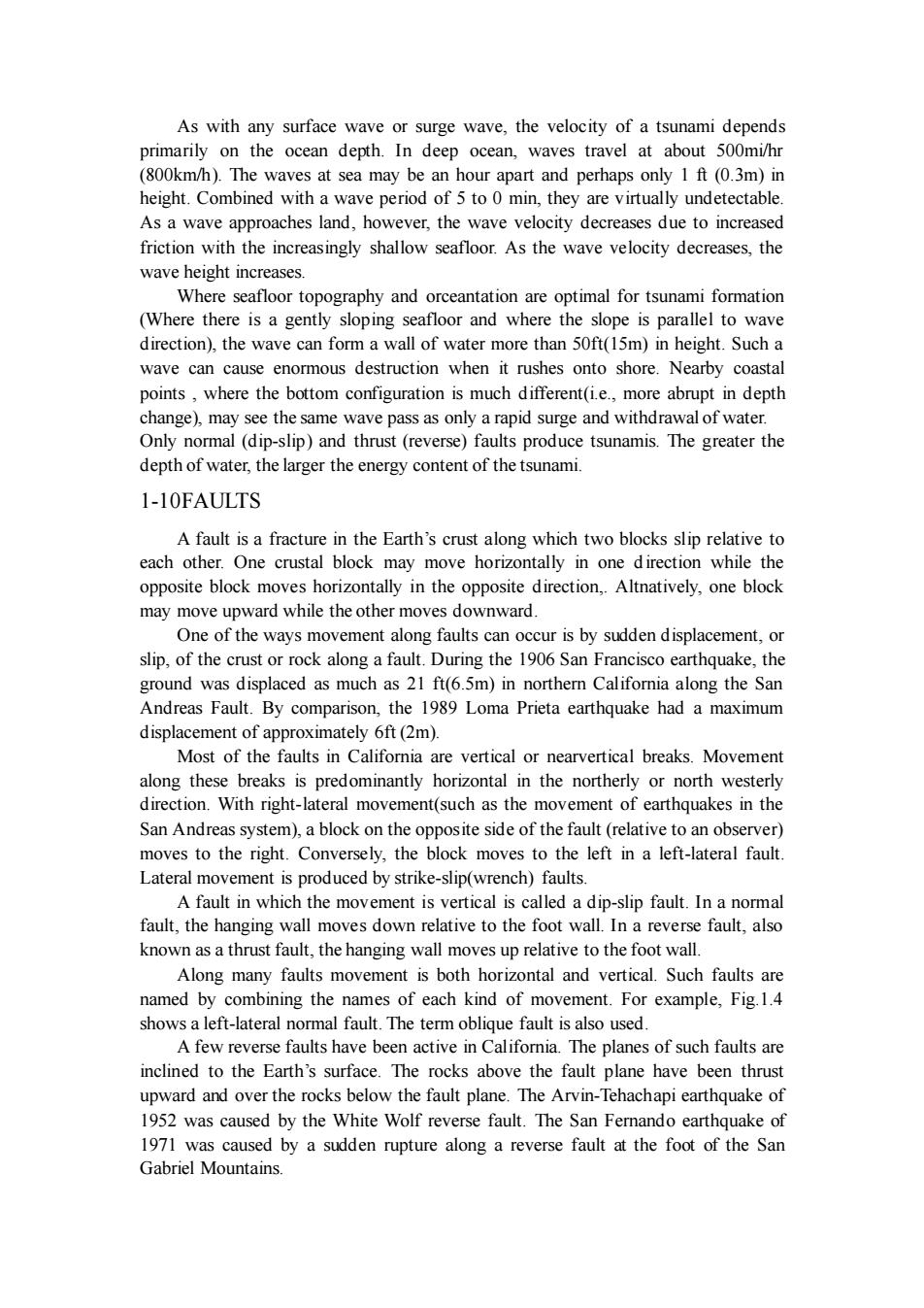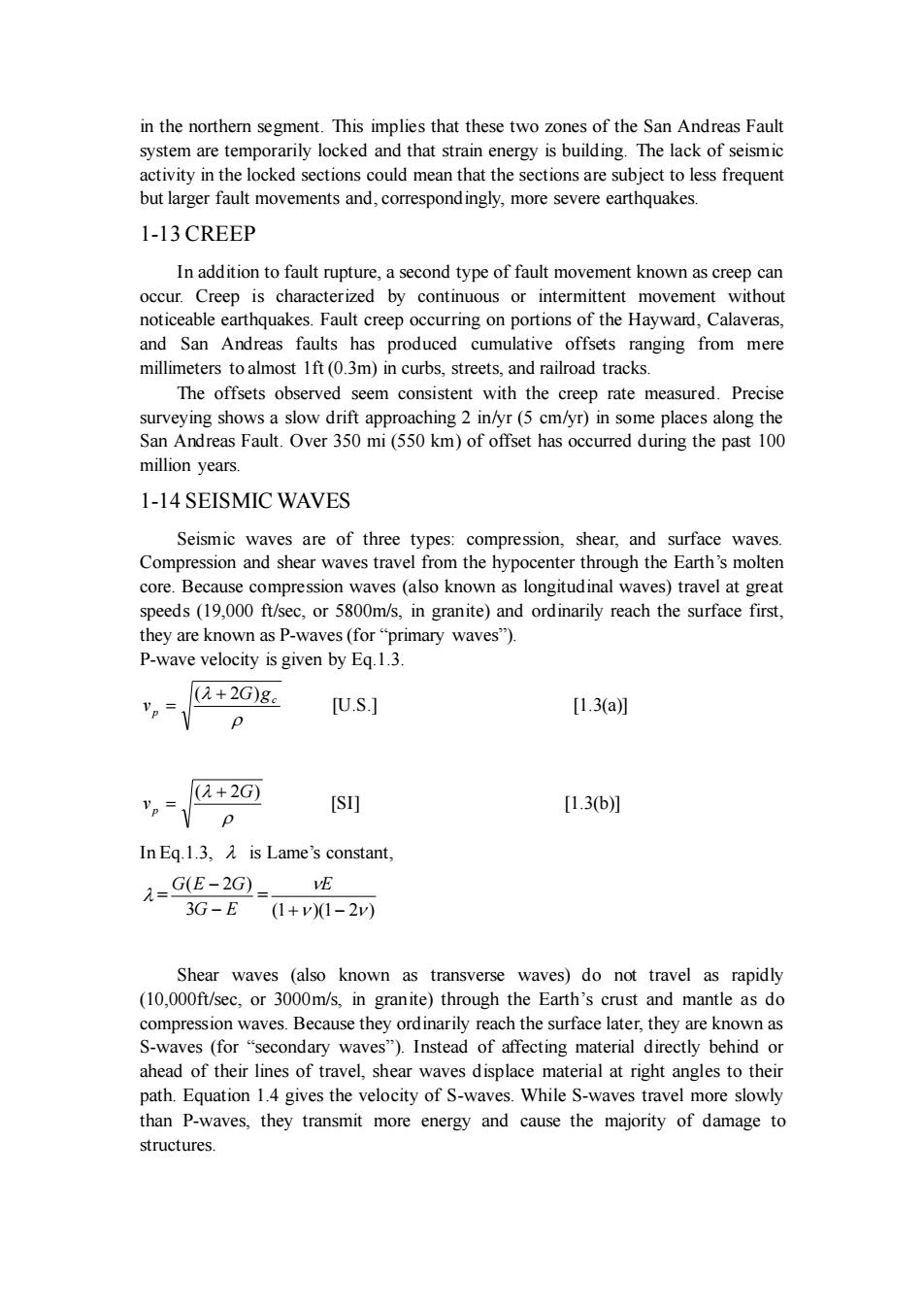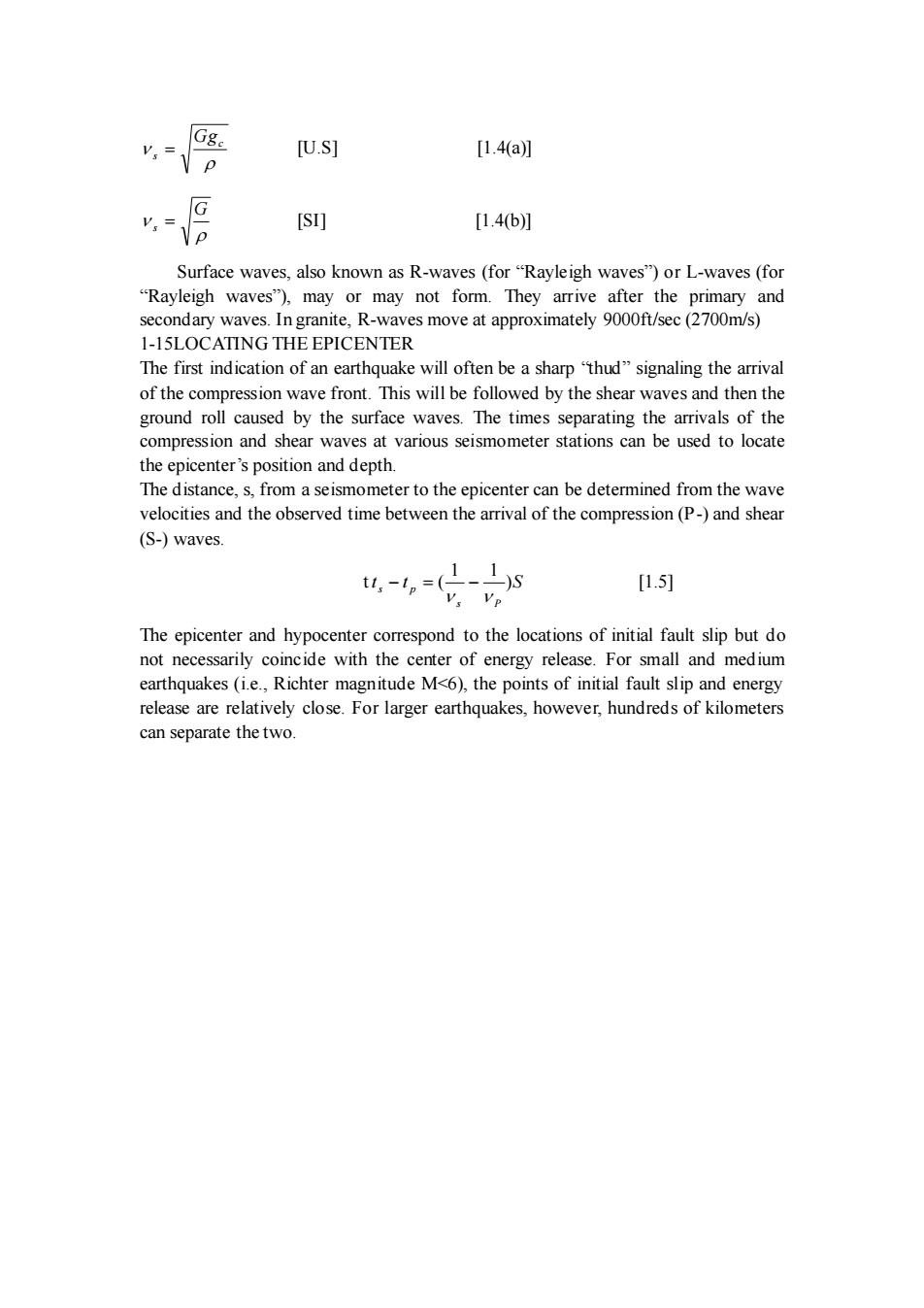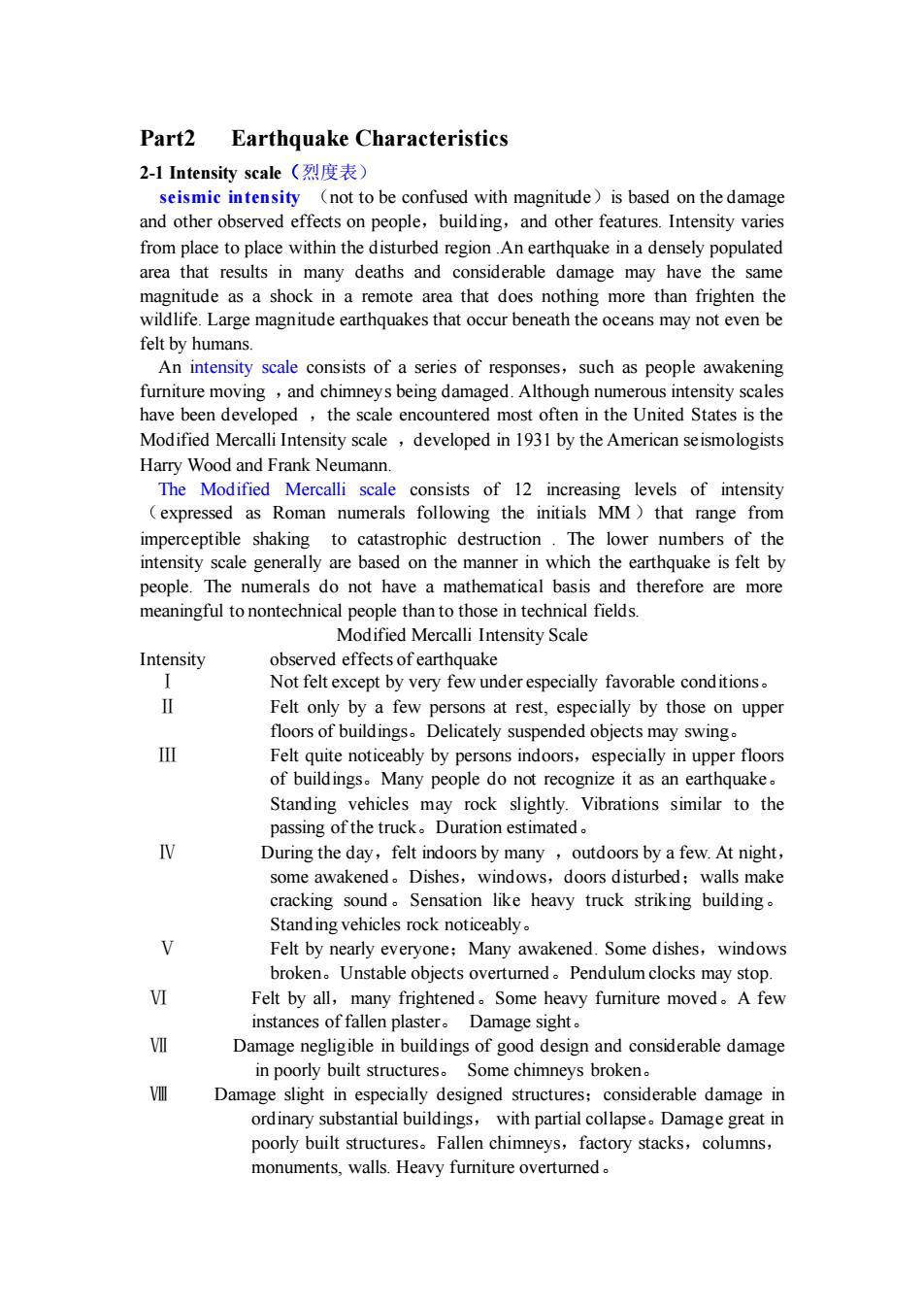
As with any surface wave orsurge wave,the velocity ofa tsunami depends on the ocean depth.In deep ocean,waves travel at about 500mi/hr (800km/h).The waves at sea may be an hour apart and perhaps only 1 ft (0.3m)in height.Combined with a wave period of 5 to 0 min,they are virtually undetectable As a wave approaches land,however,the wave velocity decreases due to increased friction with the increasingly shallow seafloor.As the wave velocity decreases,the wave height increases Where seafloor topography and orceantation are optimal for tsunami formation (Where there is a gently sloping seafloor and where the slope is parallel to wave direction),the wave can form a wall of water more than 50ft(15m)in height.Such a wave can cause enormous destruction when it rushes onto shore.Nearby coastal where the bottom configuration is much different(i.e.more abrupt in depth e the same wave pass as only a rapid surge and withdrawal of water Only normal (dip-slip)and thrust (reverse)faults produce tsunamis.The greater the depth of water,the larger the energy content of the tsunami. 1-10FAULTS A fault is a fracture in the Earth's crust along which two blocks slip relative to each other.One crustal block may move horizontally in one direction while the opposite block moves horizontally in the opposite direction.Altnatively.one block may move upward while the other moves downward. One of the ways movement along faults can occur is by sudden displacement or slip,of the ock along a fault.Dur rthquake.the und was dislaeed s much 2 f Clfom the San Andreas Fault.By comparison.the 1989 Loma Prieta earthquake had a maximum displacement of approximately 6ft(2m). Most of the faults in California are vertical or nearvertical breaks.Movement along these breaks is predominantly horizontal in the northerly or north we direction.With right lateral movement(such a the e movement of earthqua kes s in th San Andreas system),a block on the opposite side of the fault(relative to an observer) moves to the right.Conversely.the block moves to the left in a left-lateral fault Lateral movement is produced by strike-slip(wrench)faults A fault in which the movement is vertical is called a dip-slip fault.In a normal fault,the ha down relative to the foot wall.In reve fault,also known as a thrust fault,the hanging wall moves up relative to the foot wall. Along many faults movement is both horizontal and vertical.Such faults are named by combining the names of each kind of movement.For example.Fig.1.4 shows a left-lateral normal fault.The term oblique fault is also used. A few re se faults ha ve in Calif ia The pla es of such faults are inclined to the Earth's surface.The rocks above the fault plane e have been thrus upward and over the rocks below the fault plane.The Arvin-Tehachapi earthquake of 1952 was caused by the White Wolf reverse fault.The San Fernando earthquake of 1971 was caused by a sudden rupture along a reverse fault at the foot of the san Gabriel mountains
As with any surface wave or surge wave, the velocity of a tsunami depends primarily on the ocean depth. In deep ocean, waves travel at about 500mi/hr (800km/h). The waves at sea may be an hour apart and perhaps only 1 ft (0.3m) in height. Combined with a wave period of 5 to 0 min, they are virtually undetectable. As a wave approaches land, however, the wave velocity decreases due to increased friction with the increasingly shallow seafloor. As the wave velocity decreases, the wave height increases. Where seafloor topography and orceantation are optimal for tsunami formation (Where there is a gently sloping seafloor and where the slope is parallel to wave direction), the wave can form a wall of water more than 50ft(15m) in height. Such a wave can cause enormous destruction when it rushes onto shore. Nearby coastal points , where the bottom configuration is much different(i.e., more abrupt in depth change), may see the same wave pass as only a rapid surge and withdrawal of water. Only normal (dip-slip) and thrust (reverse) faults produce tsunamis. The greater the depth of water, the larger the energy content of the tsunami. 1-10FAULTS A fault is a fracture in the Earth’s crust along which two blocks slip relative to each other. One crustal block may move horizontally in one direction while the opposite block moves horizontally in the opposite direction,. Altnatively, one block may move upward while the other moves downward. One of the ways movement along faults can occur is by sudden displacement, or slip, of the crust or rock along a fault. During the 1906 San Francisco earthquake, the ground was displaced as much as 21 ft(6.5m) in northern California along the San Andreas Fault. By comparison, the 1989 Loma Prieta earthquake had a maximum displacement of approximately 6ft (2m). Most of the faults in California are vertical or nearvertical breaks. Movement along these breaks is predominantly horizontal in the northerly or north westerly direction. With right-lateral movement(such as the movement of earthquakes in the San Andreas system), a block on the opposite side of the fault (relative to an observer) moves to the right. Conversely, the block moves to the left in a left-lateral fault. Lateral movement is produced by strike-slip(wrench) faults. A fault in which the movement is vertical is called a dip-slip fault. In a normal fault, the hanging wall moves down relative to the foot wall. In a reverse fault, also known as a thrust fault, the hanging wall moves up relative to the foot wall. Along many faults movement is both horizontal and vertical. Such faults are named by combining the names of each kind of movement. For example, Fig.1.4 shows a left-lateral normal fault. The term oblique fault is also used. A few reverse faults have been active in California. The planes of such faults are inclined to the Earth’s surface. The rocks above the fault plane have been thrust upward and over the rocks below the fault plane. The Arvin-Tehachapi earthquake of 1952 was caused by the White Wolf reverse fault. The San Fernando earthquake of 1971 was caused by a sudden rupture along a reverse fault at the foot of the San Gabriel Mountains

1-11CALIFORNIA FAULTS The most earthquake-prone areas in the United States are those that are adjacent to the San Andreas Fault system of California,as well as the fault system that separates the sierra nevada from the great basin.many of the individual faults of these major systems are known to have been active during the past 200 years.Others 肥o82 been ct since the ed of the gre at ice ad nce abou g the past 200 years,many of the fau Its shown in Fig.1.5hav experienced either sudden slip or slow creep.Activity of other faults,however,can only be inferred from geologic and topographic relations that ind icate the faults have been active during the past several thousand years.Such activity suggests that these faults could slip or cree again.(See Sec.1-13.) are relatively shallow and are clearly related o movement along active faults.Many Califomnia earthquakes have produced surface rupture. 1-12 SAN ANDREAS FAULT rfault of a network that cuts through rocks of omia coastal region.This right-lateral fault s a huge fracture e more thar 600mi(950km)long.It extends almost vertically into the Earth to a depth of at least 20 mi (30km).In detail,it is a complex zone of crushed and broken rock from only a few feet wide to a mile wide.Many smaller faults branch from and join the San Andreas Fault. A linear trough in the surface of the Earth reveals the presence of the Sa Andreas Fault over much of its length.From the air,the linear arrangements of lakes. bays,and valleys are apparent.On the ground.The fault zone can be recognized by long,straight escarpments,narrow ridges,and small,undrained ponds formed by the settling of small areas of rock.However.people on the ground usually do not realize when the on near the fault. Geologists who have studied the fault between Los Angeles and San Francisco have suggested that the total accumulated displacement along the fault may be as much as 350mi (550km).Similarly,geological study of a segment of the fault between the Teion pass and the salton sea has revealed geologically similar terrains on opposite sides of the fault separated by 150 mi (250k km).This indicates that the separation is a result of movement along the San Andreas an nd branching San Gabriel faults Since 1934,earthquake activity along the San Andreas Fault system has been concentrated in three areas:(1)an off-shore area at the northernmost tip of the fault known as the Merdocino fracture zone.(2)the area along the fault between San isco and Parkfield,and (3)the sectio ughly bou Los Angeles and the border with Mexico.Creep,slip,and moderate earthquakes have occurred on a regular basis in these areas. The two zones between these three active areas have had almost no earthquakes or known slip since the great earthquakes of 1857 in the southem segment and 1906
1-11CALIFORNIA FAULTS The most earthquake-prone areas in the United States are those that are adjacent to the San Andreas Fault system of California, as well as the fault system that separates the Sierra Nevada from the Great Basin. Many of the individual faults of these major systems are known to have been active during the past 200 years. Others are believed to have been active since the end of the last great ice advance about 10,000 years ago. During the past 200 years, many of the faults shown in Fig.1.5 have experienced either sudden slip or slow creep. Activity of other faults, however, can only be inferred from geologic and topographic relations that indicate the faults have been active during the past several thousand years. Such activity suggests that these faults could slip or creep again. (See Sec.1-13.) Earthquakes in California are relatively shallow and are clearly related to movement along active faults. Many California earthquakes have produced surface rupture. 1-12 SAN ANDREAS FAULT The San Andreas Fault is the major fault of a network that cuts through rocks of the California coastal region. This right-lateral fault is a huge fracture more than 600mi (950km) long. It extends almost vertically into the Earth to a depth of at least 20 mi (30km). In detail, it is a complex zone of crushed and broken rock from only a few feet wide to a mile wide. Many smaller faults branch from and join the San Andreas Fault. A linear trough in the surface of the Earth reveals the presence of the San Andreas Fault over much of its length. From the air, the linear arrangements of lakes, bays, and valleys are apparent. On the ground. The fault zone can be recognized by long, straight escarpments, narrow ridges, and small, undrained ponds formed by the settling of small areas of rock. However ,people on the ground usually do not realize when they are on or near the fault. Geologists who have studied the fault between Los Angeles and San Francisco have suggested that the total accumulated displacement along the fault may be as much as 350mi (550km). Similarly, geological study of a segment of the fault between the Tejon Pass and the Salton Sea has revealed geologically similar terrains on opposite sides of the fault separated by 150 mi (250km). This indicates that the separation is a result of movement along the San Andreas and branching San Gabriel faults. Since 1934, earthquake activity along the San Andreas Fault system has been concentrated in three areas: (1) an off-shore area at the northernmost tip of the fault known as the Mendocino fracture zone,(2) the area along the fault between San Francisco and Parkfield, and (3) the southernmost fault section roughly bounded by Los Angeles and the border with Mexico. Creep, slip, and moderate earthquakes have occurred on a regular basis in these areas. The two zones between these three active areas have had almost no earthquakes or known slip since the great earthquakes of 1857 in the southern segment and 1906

in the northem segment.This implies that these two zones of the San Andreas Fault system are temporarily locked and that strain energy is building.The lack of seismi activity in the locked sections could mean that the sections are subject to less frequent but larger fault movements and,correspondingly,more severe earthquakes. 1-13 CREEP In addition to fault rupture,a second type of fault movement known as creep can occur.Creep is characterized by continuous or intermittent movement without noticeable earthquakes.Fault creep occurring on portions of the Hayward,Calaveras, and San Andreas faults has produced cumulative offsets ranging from mere millimeters to almost Ift(0.3m)in curbs.streets.and railroad tracks. The offsets observed seem consistent with the creep rate measured.Precise surveying shows a slow drift approaching 2 in/yr(5cm/yr)in some places along the San Andreas Fault.Over 350 mi (550 km)of offset has occurred during the past 100 million vears. 1-14 SEISMIC WAVES Seismic waves are of three types:compression,shear,and surfac e waves Compression and shear waves travel from the hypocenter through the Earth's molter core.Because compression waves (also known as longitudinal waves)travel at great speeds(19,000 ft/sec,or 5800m/s,in granite)and ordinarily reach the surface first, they are known as P-waves(for"primary waves"). P-wave velocity is given by Eq.1.3. Vp= a+2G)8 [U.S.] [1.3(a)] 0 [SI] [1.3b】 In Eq.1.3,is Lame's constant, 1=GE-2G」 E 3G-E(1+v)1-2) Shear waves (also known as transverse waves)do not travel as rapidly (10,000ft/sec,or 3000m/s,in granite)through the Earth's crust and mantle as do compression waves.Because they ordinarily reach the surface later,they are known as es(for“s aves").Instead of affecting material directly behind or ahead f their ve shear waves disp material at right anglest path.Equation 1.4 gives the velocity of S-waves.While S-waves travel more slowly than P-waves,they transmit more energy and cause the majority of damage to structures
in the northern segment. This implies that these two zones of the San Andreas Fault system are temporarily locked and that strain energy is building. The lack of seismic activity in the locked sections could mean that the sections are subject to less frequent but larger fault movements and, correspondingly, more severe earthquakes. 1-13 CREEP In addition to fault rupture, a second type of fault movement known as creep can occur. Creep is characterized by continuous or intermittent movement without noticeable earthquakes. Fault creep occurring on portions of the Hayward, Calaveras, and San Andreas faults has produced cumulative offsets ranging from mere millimeters to almost 1ft (0.3m) in curbs, streets, and railroad tracks. The offsets observed seem consistent with the creep rate measured. Precise surveying shows a slow drift approaching 2 in/yr (5 cm/yr) in some places along the San Andreas Fault. Over 350 mi (550 km) of offset has occurred during the past 100 million years. 1-14 SEISMIC WAVES Seismic waves are of three types: compression, shear, and surface waves. Compression and shear waves travel from the hypocenter through the Earth’s molten core. Because compression waves (also known as longitudinal waves) travel at great speeds (19,000 ft/sec, or 5800m/s, in granite) and ordinarily reach the surface first, they are known as P-waves (for “primary waves”). P-wave velocity is given by Eq.1.3. c p G g v ( + 2 ) = [U.S.] [1.3(a)] ( 2G) v p + = [SI] [1.3(b)] In Eq.1.3, is Lame’s constant, = G E G E G − − 3 ( 2 ) = (1 )(1 2 ) + − E Shear waves (also known as transverse waves) do not travel as rapidly (10,000ft/sec, or 3000m/s, in granite) through the Earth’s crust and mantle as do compression waves. Because they ordinarily reach the surface later, they are known as S-waves (for “secondary waves”). Instead of affecting material directly behind or ahead of their lines of travel, shear waves displace material at right angles to their path. Equation 1.4 gives the velocity of S-waves. While S-waves travel more slowly than P-waves, they transmit more energy and cause the majority of damage to structures

v.-Te [U.S] [1.4a [SI] [1.4b] Surface waves,also known as R-waves (for"Rayleigh waves")or L-waves(for "Rayleigh waves"),may or may not form.They arrive after the primary and secondary waves.In granite,R-waves move at approximately 9000ft/sec(2700m/s) 1-15LOCATING THE EPICENTER The first indication of an earthquake will often be a sharp'thud"signaling the arrival of the compression wave front.This will be followed by the shear w aves a and then the gound oll used by the surface waves.The timesseparating the rivals of the compression and shear waves at various seismometer stations can be used to locate the epicenter's position and depth. The distance,s,from a seismometer to the epicenter can be determined from the wave velocities and the observed time between the arrival of the compression (P-)and shear (S-)waves ,-4,=(2- [1.5] V Vp The epicenter and hypocenter correspond to the locations of initial fault slip but do and energy release are relatively close.For larger earthquakes,however,hundreds of kilometers can separate the two
c s Gg = [U.S] [1.4(a)] G s = [SI] [1.4(b)] Surface waves, also known as R-waves (for “Rayleigh waves”) or L-waves (for “Rayleigh waves”), may or may not form. They arrive after the primary and secondary waves. In granite, R-waves move at approximately 9000ft/sec (2700m/s) 1-15LOCATING THE EPICENTER The first indication of an earthquake will often be a sharp “thud” signaling the arrival of the compression wave front. This will be followed by the shear waves and then the ground roll caused by the surface waves. The times separating the arrivals of the compression and shear waves at various seismometer stations can be used to locate the epicenter’s position and depth. The distance, s, from a seismometer to the epicenter can be determined from the wave velocities and the observed time between the arrival of the compression (P-) and shear (S-) waves. t t t S s P s p ) 1 1 ( − = − [1.5] The epicenter and hypocenter correspond to the locations of initial fault slip but do not necessarily coincide with the center of energy release. For small and medium earthquakes (i.e., Richter magnitude M<6), the points of initial fault slip and energy release are relatively close. For larger earthquakes, however, hundreds of kilometers can separate the two

Part2 Earthquake Characteristics 2-1 Intensity scale(烈度表) seismic intensity (not to be confused with magnitude)is based on the damage and other observed effects on people,building,and other features.Intensity varies from place to place within the disturbed region.An earthquake in a densely populated area that results in many deaths and considerable damage may have the sam magnitude as a shock in a remote area that does nothing more than frighten the wildlife.Large magnitude earthquakes that occur beneath the oceans may not even be felt by humans. An intensity scale consists of a series of responses,such as people awakening fumiture moving,and chimneys being damaged.Although numerous intensity scales have heen deve eloped,the scale ountered most often in the United States is the Modified Mercalli Intensity scale,developed in 1931 by the American seismologists Harry Wood and Frank Neumann. The Modified Mercalli scale consists of 12 increasing levels of intensity (expressed as Roman numerals following the initials MM)that range from The lower num of the intensity scale generally are based on the manner in which the earthquake is felt by people.The numerals do not have a mathematical basis and therefore are more meaningful to nontechnical people than to those in technical fields. Modified Mercalli Intensity Scale Intensity rved effects of ea pt by very few under especially favorable conditio Felt only by a few persons at rest,especially by those on upper floors of buildings.Delicately suspended objects may swing. Felt quite noticeably by persons indoors,especially in upper floors of buildings.Many people do not recognize it as an earthquake. Standing ehicles ock slightly. ibrations similar to the Duration estimated During the day,felt indoors by many outdoors by a few.At night, some awakened.Dishes,windows,doors disturbed:walls make cracking sound Sensation like heavy truck striking building Standing vehicles rock noticeably Felt by nearly everyone:Many awakened.Some dishes, windows broken.Unstable objects overturned.Pendulum clocks may stop. Felt by all,many frightened.Some heavy fumiture moved.A few instances of fallen plaster。Damage sight。 Damage negligible in buildings of good design and considerable damage in p ly built stru tures. Some chimneys broker Damage slight in especially designed structures:considerable damage in ordinary substantial buildings,with partial collapse.Damage great in poorly built structures.Fallen chimneys,factory stacks,columns, monuments.walls.Heavy furniture overturned a
Part2 Earthquake Characteristics 2-1 Intensity scale(烈度表) seismic intensity (not to be confused with magnitude)is based on the damage and other observed effects on people,building,and other features. Intensity varies from place to place within the disturbed region .An earthquake in a densely populated area that results in many deaths and considerable damage may have the same magnitude as a shock in a remote area that does nothing more than frighten the wildlife. Large magnitude earthquakes that occur beneath the oceans may not even be felt by humans. An intensity scale consists of a series of responses,such as people awakening furniture moving ,and chimneys being damaged. Although numerous intensity scales have been developed ,the scale encountered most often in the United States is the Modified Mercalli Intensity scale ,developed in 1931 by the American seismologists Harry Wood and Frank Neumann. The Modified Mercalli scale consists of 12 increasing levels of intensity (expressed as Roman numerals following the initials MM)that range from imperceptible shaking to catastrophic destruction . The lower numbers of the intensity scale generally are based on the manner in which the earthquake is felt by people. The numerals do not have a mathematical basis and therefore are more meaningful to nontechnical people than to those in technical fields. Modified Mercalli Intensity Scale Intensity observed effects of earthquake Ⅰ Not felt except by very few under especially favorable conditions。 Ⅱ Felt only by a few persons at rest, especially by those on upper floors of buildings。Delicately suspended objects may swing。 Ⅲ Felt quite noticeably by persons indoors,especially in upper floors of buildings。Many people do not recognize it as an earthquake。 Standing vehicles may rock slightly. Vibrations similar to the passing of the truck。Duration estimated。 Ⅳ During the day,felt indoors by many ,outdoors by a few. At night, some awakened。Dishes,windows,doors disturbed;walls make cracking sound。Sensation like heavy truck striking building。 Standing vehicles rock noticeably。 Ⅴ Felt by nearly everyone;Many awakened. Some dishes,windows broken。Unstable objects overturned。Pendulum clocks may stop. Ⅵ Felt by all,many frightened。Some heavy furniture moved。A few instances of fallen plaster。 Damage sight。 Ⅶ Damage negligible in buildings of good design and considerable damage in poorly built structures。 Some chimneys broken。 Ⅷ Damage slight in especially designed structures;considerable damage in ordinary substantial buildings, with partial collapse。Damage great in poorly built structures。Fallen chimneys,factory stacks,columns, monuments, walls. Heavy furniture overturned